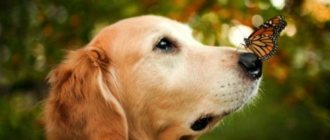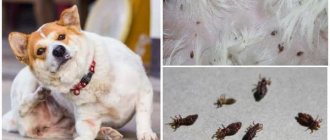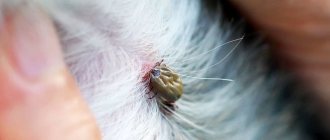The expression “like a cat and a dog” has acquired the status of a phraseological unit, reflecting not only the mutual dislike of pets, but also the long-standing and irreconcilable confrontation between the two clans. According to Chinese legend, a dog once pulled a drowning girl from an ancient rich family from the water. As a sign of gratitude, the ruler ordered a decree to be attached to the dog’s tail stating that from now on all strays should be fed and cherished. To celebrate, all the dogs in the area had a feast, and the precious paper was given to the cat for safekeeping. But at dawn the letter disappeared, causing a storm of indignation among the dog tribe. The cat blamed everything on the mice, who allegedly chewed the paper into dust. Since then, all dogs dislike cats, and cats catch mice in retaliation. And in the secret hope of finding the stolen treasure, all the dogs sniff each other's tails when they meet.
Eternal competitors
According to research by archaeozoologists, the ancestors of cats appeared in Africa, and the ancestors of dogs appeared on the American continent. Over millions of years, they gave rise to numerous species branches, but existed separately, and only after the next tectonic changes, which led to the unification of the continents, did counter migration begin.
The spread and collision of alien predators resulted in fierce competition for territory and food. Over time, the saber-toothed mahairod tigers and dire wolves of the Pleistocene became extinct, but genetic memory keeps modern cats and dogs still at odds.
Hunting instinct
The zeal of dogs for cats can also be explained by the hunting instincts inherent in many breeds. For such dogs, many animals are regarded as potential prey, regardless of whether the cat is a raccoon or a fox, therefore, in dogs, the hunting instinct is triggered, and in cats, the instinct of self-preservation begins and the chase and hostility begin.
© shutterstock
Fight for territory
The domestic cat has a pronounced territorial instinct, illustrating the saying that whiskered tabby cats are more attached to a place than to their owner. Thus, Murka clearly considers an apartment, a private house, and even the entire owner’s yard to be his property.
Mature males are especially vigilant in monitoring their possessions, staging noisy showdowns and brutal fights with strangers.
In the wild, canines and cats living in the same territory are competitive predators, which means they are forced to divide hunting grounds and defend their boundaries:
- Yard cats . The territory of a street cat “walking on its own” is very vast, and not only fellow cats, but also dogs fall into the category of uninvited guests. That is why the cat, comfortably dozing on a bench at “his” entrance, will arch and hiss when he sees the approaching dog.
- Dogs . Dogs, in turn, also diligently mark the territory with urine marks and bark at the aliens. In R. Kipling’s fairy tale, the Dog’s appeal to the Cat sounds like a sign and an oath of eternal hatred: “Walk, walk, but not where I am. Otherwise I’ll bark, run at you and drive you up a tree. And so will all dogs do, from now on and forever and ever.”
Frontiers on lock
Dogs and cats have completely opposite ideas and outlooks on life. The dog is a collective animal, in nature it lives in packs, and its fellow tribesmen are of great importance to it. A cat, on the contrary, “walks on its own” values solitude, catches prey on its own, eats it itself, and does not share it with anyone. But these animals have one thing in common: both animals are territorial, accustomed to guarding their borders and protecting them from outsiders.
Dogs and cats are predatory animals; protecting their territory is very important for them, just as it is for a hunter to protect their territory. One of the reasons why dogs hate cats is because they claim territory. It is easier for packs to win a place in the sun, so dogs took the lead. Weight and size are secondary causes. The ancestors of domestic cats were not inferior in size to dogs, but failed because they preferred loneliness.
Dogs chase cats because a pack is quite effective against one enemy, but today's domestic cat has not lost its courage. And if it had been the other way around, a pack of cats for one dog, it remains to be seen who would have won.
There is another version: competition at the genetic level. It is possible that the ancestors of domestic cats were saber-toothed tigers, which at one time greatly offended the canine family, and this is the basis for dogs’ rejection of cats. The desire to take revenge on the descendants of one’s enemies occurs at the genetic level.
The struggle for food resources
In nature, the diet of canines and cats is very wide, including dozens of species: from deer and hares to mice, lizards and even insects, and only big cats hunt exclusively large mammals. In times of hunger, both cats and dogs can eat carrion, without disdaining dead animals and the remains of someone else's dinner. And only the cheetah's menu consists of fresh meat from freshly caught prey.
In human society, cats and dogs also compete for food. But while stray dogs tend to eat garbage or devour puppies and weakened relatives, cats easily adapt to any environmental conditions, quickly run wild and hunt successfully.
Even those cats that live in the house, but are released by their owners to walk on their own, on average catch 60 small animals per year, including mice, birds and rats.
Misunderstanding each other
You might think that since animals cannot agree with each other, it means that one of them is not very smart. A cat and a dog are like the French and the Chinese, knowing only their own languages. People can agree with each other using gestures that have common meanings, but with pets this is much more difficult.
By wagging its tail, a dog shows its disposition towards something; in a cat it means anxiety, concern, aggression. When a dog sits down, slightly wags its tail, presses its ears down on its lowered head, and visually strives to shrink, it means that it is guilty and completely submits. The cat presses its ears and bends down before attacking. Cats fall on their backs and put their clawed paws forward when they should actively defend themselves, while dogs with this pose show you complete trust and submission. With such differences in behavior, it is quite difficult for them to understand each other.
Advantage of the Pack
The joint actions of social animals, which are canines, have many advantages over individualistic cats, who are forced to independently take care of their food and safety:
- A threat to singles . Despite caution and developed instincts, small and medium-sized cats in nature become frequent prey for canines. Thus, the young of the European forest cat are devoured by wolves, foxes and jackals, the slow-moving Pallas cats are successfully hunted by wolves, and the light-footed coyote easily catches up and kills stray cats. A lynx, although it weighs one and a half to two times less than a wolf, poses a serious danger in single combat with it. At the same time, wolves hunting in a pack surround the fleeing lynx, attack in a group and tear it to shreds. Hunters know that in places where there are a lot of wolves, “the lynx doesn’t stick around.” A seasoned lynx, scared from its resting place, flees from a pack of hunting dogs and can run up to 4-6 km before its strength begins to run out. The overtaken animal accurately assesses the situation and, being pursued by one dog, takes up a perimeter defense and fights on the ground. Moving away from the pack, the lynx uses a trivial cat trick and climbs a tree, hoping to sit there. If a shot from a hunter who arrives in time does not kill it outright, then a wounded cat falling down can seriously injure and even kill the dog, desperately clinging to life.
- Run, murka, run! The pack lifestyle allowed dogs to occupy a dominant position even in the conditions of the “concrete jungle,” forcing cats to habitually retreat. Undoubtedly, the difference in size plays a significant role, but even terriers weighing 5-8 kg frantically chase the neighbor's cats, feeling like they are the masters of the area. Thanks to its flexibility and maneuverability, the running cat demonstrates the skill of parkour, avoiding obstacles and climbing to a saving tree or other height inaccessible to the enemy. A single chase most often turns out to be fruitless, but a flock can push the cat away from the shelter and collectively work for destruction.
Smart but different
If you ask about the mental abilities of animals, most people will say that, of course, a dog is much smarter than a cat. They perfectly follow commands, are obedient, they can even distinguish the words and mood of the owner, the pack lifestyle has affected the dogs’ communication skills, they are good companions, dogs can predict where an object is located and the speed of its movement. A hungry dog will get to food faster.
If a dog gives a voice when commanded to lie down or attacks an opponent, this does not mean that it is smarter. The cat will never obey the owner's commands; if only its desires coincide with the owner's command, it will obediently complete the task. Dogs recognize their reflection in the mirror, but may not recognize the owner if he comes in different clothes and smells unfamiliar. A cat cannot recognize itself in the mirror, but it will never confuse its owner.
Both animals are perfectly oriented in space and easily find their way home, but the cat has more possibilities. She can run not only on the ground, but also climb fences and tall trees, because, unlike dogs, she lives in three-dimensional space. Dogs are extroverts, love to show their emotions, and tend to get closer. Cats by nature are introverts, completely immersed in their own world, closed and not inclined to communicate.
The cat has proven its intelligence by surviving in extreme conditions all alone, in which a dog can survive only as part of a pack. Only after people know the thoughts of animals will it be possible to confidently say who is smarter.
Are cats afraid of dogs?
It is commonly believed that cats run away from dogs out of fear for their lives. But, as practice shows, the outcome of the meeting may not be so clear:
- Caution is not cowardice. Ethologists argue that what makes a cat run away from a dog is not fear, but an unwillingness to take risks, since the instinct of self-preservation in solitary animals is more subtle and sensitive. This is exactly how a yard cat behaves when a dog appears: it presses itself to the ground, freezes and carefully “scans” the potential enemy, assessing its reaction and its chances. This triggers the hiding instinct, since cats cannot run in a straight line for a long time and quickly, unlike canines, who are “fed by their legs.” If a dog passes by, the cat remains in place with the imperturbable look of a Zen Buddhist, but can react to an attack in two ways: run or fight. The excitement of the hunt commands the dogs to rush after them, although the mustache-striped dogs become a potential food object only during the hungriest period.
- There is no beast more terrible than a cat . The prevalence of active defense clearly indicates a lack of fear. There are many known cases where murkas, using all their “combat potential”, turned large dogs into a shameful flight. The little angry demon grabbed the dog’s face with all four paws with 18 claws and, using his teeth, inflicted serious wounds. Mother cats fight especially fiercely to protect their cubs.
- When dogs are victims . In the wild, the size of large cats allows them to be at the top of the food chain. Thus, the Amur tiger does not favor wolves and mercilessly drives them out of its territory, since with their noisy baiting they scare away the prey that the owner of the taiga is accustomed to killing in ambush. Lynx kill foxes on occasion, and cougars kill coyotes and wolves. Domestic dogs turn out to be easy prey for large wild cats: for example, Bengal tigers drag mongrels straight from Indian settlements, and African savannah leopards lie in wait for them in the thickets. In Khabarovsk and the Amur region, Amur tigers, weakened by old age and illness, are unable to defeat an elk or a deer, and from time to time they bully yard dogs sitting on a chain.
Also watch the video why cats and dogs fight:
Official theory
There are many more interesting myths and tales among the people about the reasons for mutual dislike between animals. But these are just fairy tales. People who study the habits of pets give more plausible explanations for the cause of hostility:
Different behavior. A cat and a dog are diametrically opposed creatures. The dog is a noisy creature that loves to run, bark, and frolic. Let your dog into an unfamiliar apartment, and he will immediately rush to explore and inspect the rooms.
And a calm, unperturbed adult cat prefers to lie more, looking around. She is characterized by innate isolation and indifference. Philosophers! But this behavior is typical of cats who are wise in life - young fluffies behave differently.
Curious dogs, wanting to get to know the cats, run towards them. Outraged by the shamelessness, the cats quickly run away, trying to scare off the impudent ones with their hissing and raised fur. This provokes the mischievous dogs even more – a fun chase begins.
Here we should also take into account the “Jewish” character of the purrs, who consider the place in which they live (a house, an apartment and even a street) to be their personal, inviolable property. The arrogance of dogs is immediately suppressed - cats aggressively defend their territory.
"Predatory" legacy. Dogs are driven to chase cats by an innate instinct that is transmitted genetically. Dogs are hunters by nature and will run after any moving object. Hunting habits intensify when the dog is outdoors. There is a similar, but diametrically opposed theory:
The wild ancestors of cats (lions, tigers, panthers, leopards) always pursued small relatives of dogs (hyenas, jackals, coyotes). The fear of big cats is ingrained in the subconscious of canines. Seeing the little purrs, the barking pets begin to take revenge. Instincts are awakened by the smell of a cat.
Unpleasant memories. Sometimes the kitty is quite peaceful and doesn’t mind playing with the dog. But the dog refuses the friendly relationship and snaps at the cat. This reaction is caused by unpleasant memories (a young dog was offended by a cat, scratching a curious person on the nose). The dog grew up, but the hostility and fear of purrs remained, fixed in the subconscious.
The owner's character. Owners of tailed pets are also capable of developing a hostile attitude towards cats. If a person is loyal to purrs, the dog, looking at him, will not show negative emotions.
But as soon as the owner demonstrates hostility towards felines, the dog duplicates human feelings. Enmity appears between pets.
This is interesting. Speaking about the difference in the behavior of animals, one curious feature was noticed - verbal contact. Dogs and cats have diametrically different body signals:
- A dog's tail wagging means interest and affection. In cats, tail movements indicate irritation or danger.
- When cats purr, they express pleasure. And the grumbling of dogs means a threat and a warning of an attack.
- If the dog raises his paw, he offers to play. The cat perceives this as a threatening action.
- Cat-like arching is a pose that signals an upcoming attack. And the dog, who does not understand this, reaches out to sniff the strange creature or lick it, getting hit in the face with a paw with sharp claws.
Animals perceive verbal signals differently. This is the source of misunderstanding. What to do?
How to make friends of different ages
To quickly make friends with animals, you need to treat them correctly. The idea that a cat and a dog are sworn enemies is a myth. The behavior of pets and their perception of each other completely depends on their upbringing; the issue of friendship largely depends on the literacy of the owner.
It is easier to make friends with a puppy and a kitten that appeared in the house at the same time. It is important to follow the rules:
- provide everyone with personal belongings;
- regularly spend time together playing with the two of them;
- pay attention to each individually.
At a young age, animals perceive each other as friends. They are always ready to play, and it is easy to teach them to live together. If one of the pets is an adult, it will take more patience and strength to make friends with the new inhabitant in the house.
Adult cat and puppy
It is often difficult to make friends with a puppy and a cat. Usually, cats are not subject to special training; there is no point in hoping that they will obey their owner without offending the new inhabitant of the house.
Breed plays an important role. Representatives of some, Siamese, Maine Coon, British, are distinguished by their aggressive character. Usually they are not happy even with guests coming to the owner, much less will they perceive a small puppy as hostile. If you have never raised a cat and know how aggressive he is, it is better to avoid getting a puppy.
Representatives of most breeds have a gentle character. Especially affectionate Persian and Devon Rex. They will perceive the arrival of a puppy more calmly. The first reaction is likely to be curiosity, a little stress, and then friendliness.
If the cat was already in the apartment before the puppy arrived and accepted it normally, the owner’s main task is to protect it from excessive stress. The cat's favorite place should remain the same so that she feels confident. Puppies of any breed are playful and restless at a young age, so the owner must pay personal attention to them. Even if a cat spends time with a small inhabitant of the apartment, it should always have the opportunity to retire by climbing into its own place.
It is better for the cat’s territory to be an area on a hill where the puppy cannot reach. They usually like to observe what is happening around them while remaining untouched.
Adult dog and kitten
Sometimes getting a kitten to live with a dog in the same apartment is contraindicated. This applies to cases where the dog is ill-mannered and untrained. Representatives of large breeds, not accustomed to following commands, will immediately show aggression, and the situation often ends in failure.
In other cases, when the dog is a sane, well-mannered pet, you can make friends with a kitten. You should prepare by following a number of rules:
- make sure that the dog understands and follows all commands, especially prohibitive ones;
- divide the territory between two people so that each animal has its own area, immediately accustom both to this;
- It is desirable that the sleeping places be separate, in different rooms.
It is possible to make friends between an adult dog and a kitten if you do not put pressure on it, forcing it to accept the new inhabitant of the apartment against its will. It is important for the dog to get used to the new smell, which will now be constantly present in the room. It is better for representatives of large breeds not to show the kitten at all on the first day. They immediately sense its appearance and must get used to it.
The first meeting of a kitten with an adult dog occurs carefully. They put a strict collar on her, no matter how well-mannered and obedient she is. Animals must be kept at a distance. The latter poses a particular danger when introducing a dog to a kitten. He can dig into the dog with his claws, scratching him. This is a bad start to dating; it is difficult to reconcile the animals later.
Experts advise trimming the claws of small kittens so that they do not even accidentally harm the dog.
It is recommended to allow closer contact after staying at a distance. An indicator that they have accepted each other will be free sniffing of each other. To achieve this, sometimes you need to introduce them once; other owners have to spend several days on this.
After getting to know each other, you need to be especially careful about the time you spend with your dog. She shouldn't feel abandoned. Play together, separately. Continue to walk your pet and comply with other maintenance conditions. Let the dog feel its authority in the house; you cannot take things from it and give them to the kitten, or infringe on its territory.
Both adults
The situation is much more complicated when two adult animals appear in the house. Some take them from nurseries at the same time. Sometimes owners decide to adopt an adult animal when they have another adult pet. Everyone has their own formed character, habits, the taming of which is difficult.
Don't force the idea of friendship on animals. The main task of the owner is to prevent possible hatred, they must get used to each other, warm relations can appear after months. If the nature of the representatives of the breed makes them not inclined to communicate closely with other animals, they cannot be forced.
Provide everyone with their own territory. Care and maintenance of a pet is individual, it must be carried out to the fullest extent. Cats and dogs are sensitive animals that react acutely to infringement of attention and need the owner’s time. Before getting two adult pets, consider whether you have:
- experience in keeping pets;
- time for animals;
- the ability to provide care for pets during vacation;
- knowledge to raise them correctly;
- the opportunity to provide them with a separate territory at home;
- the desire to devote one’s strength and patience to education.
Much depends on the owner, so by remaining indifferent to the life of animals, you can harm them and yourself.











